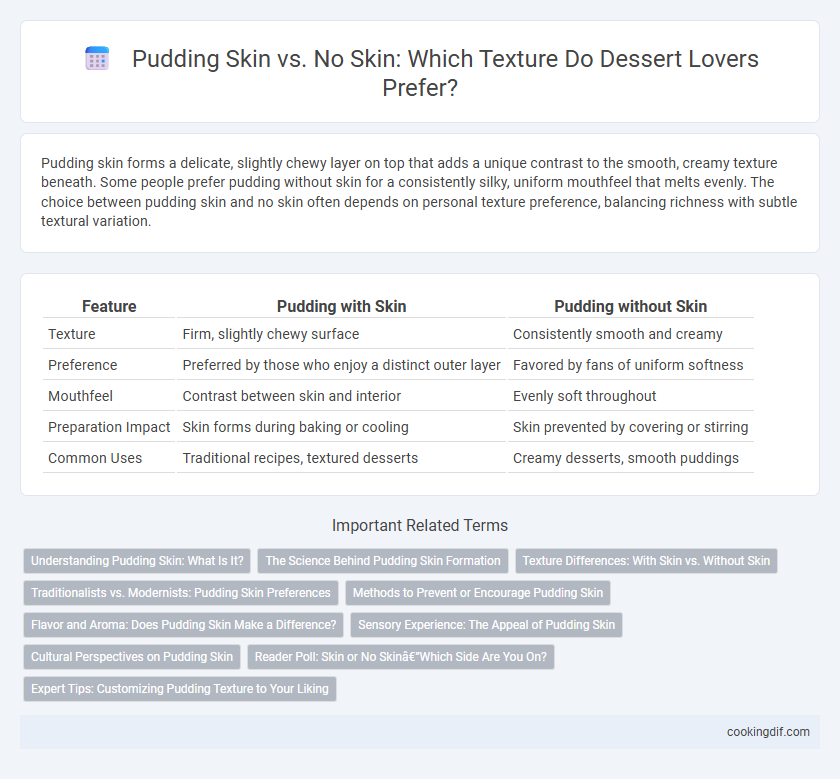Pudding skin forms a delicate, slightly chewy layer on top that adds a unique contrast to the smooth, creamy texture beneath. Some people prefer pudding without skin for a consistently silky, uniform mouthfeel that melts evenly. The choice between pudding skin and no skin often depends on personal texture preference, balancing richness with subtle textural variation.
Table of Comparison
| Feature | Pudding with Skin | Pudding without Skin |
|---|---|---|
| Texture | Firm, slightly chewy surface | Consistently smooth and creamy |
| Preference | Preferred by those who enjoy a distinct outer layer | Favored by fans of uniform softness |
| Mouthfeel | Contrast between skin and interior | Evenly soft throughout |
| Preparation Impact | Skin forms during baking or cooling | Skin prevented by covering or stirring |
| Common Uses | Traditional recipes, textured desserts | Creamy desserts, smooth puddings |
Understanding Pudding Skin: What Is It?
Pudding skin forms as a thin, delicate layer on the surface of pudding due to protein and starch molecules coagulating when exposed to heat and air. This film is often appreciated for its unique, slightly firmer texture contrasting with the smooth, creamy pudding beneath. Preferences vary as some enjoy the added tactile dimension of pudding skin, while others prefer a uniformly silky consistency without any surface film.
The Science Behind Pudding Skin Formation
Pudding skin forms due to the evaporation of water from the pudding's surface, causing proteins and other solids to concentrate and create a thin, gelatinized layer. This skin affects texture by adding a slightly firmer, sometimes rubbery contrast to the smooth, creamy interior. The presence or absence of pudding skin is controlled by factors like cooking temperature, humidity, and stirring frequency during preparation.
Texture Differences: With Skin vs. Without Skin
Pudding skin forms a thin, slightly chewy layer on top, creating a contrast between the smooth, creamy interior and the firmer exterior, which offers a unique textural experience. Without skin, pudding maintains a uniform silky consistency throughout, appealing to those who prefer a smooth, velvety mouthfeel without any textural interruption. The presence or absence of pudding skin significantly influences the sensory enjoyment, with skin adding complexity while no skin emphasizes a consistent, creamy texture.
Traditionalists vs. Modernists: Pudding Skin Preferences
Traditionalists prefer pudding with skin, valuing the rich, creamy texture formed as the surface cools and sets, which enhances the dessert's authentic flavor profile. Modernists favor skinless pudding for its smooth, uniform consistency that emphasizes the custard's silky mouthfeel without the slight bitterness sometimes found on the skin. Texture preference hinges on whether one values the traditional tactile contrast or the streamlined creaminess of pudding.
Methods to Prevent or Encourage Pudding Skin
Pudding skin forms when a layer of protein and fat solidifies on the surface as it cools, creating a firmer, slightly chewy texture prized by some but avoided by others. To prevent pudding skin, covering the surface with plastic wrap or placing a damp cloth over the pudding during cooling limits air exposure and moisture loss. Encouraging pudding skin involves leaving the pudding uncovered to allow evaporation and cooling, which enhances the skin's characteristic texture preferred in traditional recipes.
Flavor and Aroma: Does Pudding Skin Make a Difference?
Pudding skin intensifies the flavor by concentrating caramelized sugars and offering a richer, slightly toasted aroma that enhances the overall sensory experience. Without skin, pudding delivers a smoother texture but a more subtle flavor and milder aroma, emphasizing creaminess over complexity. For flavor enthusiasts, pudding skin provides a deeper, more robust taste profile that complements aromatic notes often lost in skinless versions.
Sensory Experience: The Appeal of Pudding Skin
Pudding skin forms a delicate, slightly chewy layer on the surface, offering a contrast to the creamy interior that enhances the sensory experience through varied textures. Some consumers enjoy the skin for its unique mouthfeel and subtle caramelized flavor, which adds complexity beyond smooth pudding. Others prefer no skin to maintain a uniformly silky texture, favoring a pure, creamy sensation without interruption.
Cultural Perspectives on Pudding Skin
In Japanese culture, pudding skin, known as "pudding no kawa," is cherished for its delicate, slightly firmer texture that contrasts with the smooth custard beneath. Western preferences often lean toward skinless pudding, valuing a consistently creamy texture free from any film or crust. These cultural differences highlight how textural variations in pudding can significantly influence enjoyment and traditional dessert appreciation.
Reader Poll: Skin or No Skin—Which Side Are You On?
Pudding skin, the thin film that forms on the surface as it cools, offers a slightly chewy texture contrasted with the smooth, creamy consistency of skin-free pudding. Reader polls reveal a near-even split in preference, with some favoring the unique mouthfeel and slight firmness of the skin, while others reject it for a uniform, velvety texture. This divide highlights personal sensory preferences, making pudding skin a key factor in overall eating experience.
Expert Tips: Customizing Pudding Texture to Your Liking
Experts recommend adjusting the cooking temperature and cooling method to control pudding skin formation, which impacts texture preference by creating a firmer top layer that contrasts with the creamy interior. For a smooth, skin-free pudding, frequent stirring during cooling and covering the surface with plastic wrap ensures even texture without a film. Tailoring these techniques allows you to customize pudding to your preferred mouthfeel, whether you desire silky smoothness or a slight textural contrast.
Pudding skin vs no skin for texture preference Infographic

 cookingdif.com
cookingdif.com